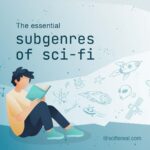Sci Fi future technology predictions turned real

It is no surprise that Sci Fi future technology predictions have emerged in the real world in technology we can use today. Science fiction literature has often served as a precursor to real-world technological advancements, inspiring scientists, engineers, and innovators to turn imaginative concepts into tangible realities.
Which technology predictions described in science fiction works came true in the real world and we use today?
In science fiction, writers have long dared to envision futures brimming with fantastical technologies, pushing the boundaries of imagination and speculation. As time unfolds, many of these once-fanciful concepts have transcended the realm of fiction to become tangible realities. From space travel to artificial intelligence, the intersection of human ingenuity and technological advancement has seen the fruition of predictions once confined to the pages of speculative fiction. Delving into sci-fi literature, ideas once only imagined have since materialized, shaping our present and illuminating the limitless potential of the future as Sci Fi future technology predictions turn real.
Submarines
Jules Verne’s “20,000 Leagues Under the Sea” famously featured the Nautilus, a technologically advanced submarine capable of underwater exploration. Today, submarines are integral to military operations, scientific research, and underwater exploration, with advancements in design and propulsion enabling deep-sea exploration and surveillance.
Jet Engines
The concept of jet propulsion was explored in science fiction stories like H.G. Wells’s “The War in the Air” and Robert A. Heinlein’s “Rocket Ship Galileo.” Today, jet engines power commercial airliners, military aircraft, and spacecraft, offering fast and efficient transportation for passengers and cargo around the world.
Internet
Science fiction writers like William Gibson, in his novel “Neuromancer,” envisioned a vast network of interconnected computers known as the “Matrix.” Today, the internet has evolved into a global network that facilitates communication, information sharing, commerce, and entertainment on an unprecedented scale.
Tablet Computers
In the 1968 novel “2001: A Space Odyssey” by Arthur C. Clarke, characters use what are essentially tablet computers. Today, tablets like the iPad have become commonplace, revolutionizing how we consume media, work, and communicate on portable devices.
Voice Control
Science fiction stories like “Star Trek” and “2001: A Space Odyssey” depicted characters interacting with computers and devices using voice commands. Today, voice control technology is integrated into smartphones, smart speakers, and other electronic devices, allowing users to perform tasks and access information hands-free.
Voice-Activated Assistants
The concept of interacting with computers via voice commands was popularized by the Star Trek franchise, particularly the ship’s computer in the original series, voiced by Majel Barrett. Today, voice-activated assistants like Siri, Alexa, and Google Assistant have become integral parts of our daily lives, helping us perform tasks, answer questions, and control smart devices.
Video Calling
Science fiction author H.G. Wells wrote about a device called the “telectroscope” in his 1899 story “When the Sleeper Wakes.” This device allowed for long-distance video communication, foreshadowing modern video calling technology used in applications like Skype, FaceTime, and Zoom.
Wearable Technology
Science fiction works like William Gibson’s “Neuromancer” and Neal Stephenson’s “Snow Crash” depicted characters wearing augmented reality glasses and other wearable devices. Today, wearable technology such as smartwatches, fitness trackers, and augmented reality headsets have become ubiquitous, enhancing our daily lives with real-time information and connectivity.
Facial Recognition
The concept of facial recognition technology featured in science fiction films like “Blade Runner” and “Minority Report”, where it was used for surveillance and identification purposes. Today, facial recognition systems are used for security, law enforcement, and authentication in various industries, raising concerns about privacy and civil liberties.
Fingerprint Scanners
While fingerprint identification predates science fiction, the idea of using fingerprint scanners for security purposes was popularized in works like Arthur Conan Doyle’s “Sherlock Holmes” stories and various spy novels. Today, fingerprint scanners are commonly used for biometric authentication in smartphones, laptops, and access control systems.
Self-Driving Cars
Science fiction stories like Isaac Asimov’s “I, Robot” and Philip K. Dick’s “Minority Report” depicted autonomous vehicles navigating city streets. While fully autonomous cars are still in development, semi-autonomous features like lane-keeping assist and adaptive cruise control are already available in many vehicles, paving the way for a future of self-driving transportation.
Augmented Reality
The concept of overlaying digital information onto the physical world was popularized in works like Vernor Vinge’s “Rainbows End” and Ernest Cline’s “Ready Player One.” Today, augmented reality technology is used in applications like Pokémon GO and Snapchat filters, as well as in industrial and educational settings.
Bionic Limbs
Science fiction stories like “The Six Million Dollar Man” by Martin Caidin and “Cyborg” by Martin Caidin envisioned characters with bionic limbs that grant enhanced strength and functionality. Today, advancements in prosthetics have led to the development of bionic limbs equipped with sensors and actuators that can respond to neural signals from the user’s brain.
Personalized Medicine
The idea of tailored medical treatments based on individual genetic makeup was explored in novels like Greg Bear’s “Blood Music” and Michael Crichton’s “Next.” Today, personalized medicine approaches, such as pharmacogenomics and gene therapy, are revolutionizing healthcare by offering targeted therapies with increased efficacy and fewer side effects.
Virtual Reality
Science fiction works like Neal Stephenson’s “Snow Crash” and Ernest Cline’s “Ready Player One” depicted immersive virtual worlds where users can interact with computer-generated environments. Today, virtual reality technology has advanced to the point where users can experience highly realistic simulations for entertainment, training, and therapeutic purposes.
Teleportation
While teleportation as depicted in science fiction may still be a distant dream, the concept of instant transportation of matter was popularized in works like “Star Trek” and “The Fly.” Today, quantum teleportation experiments have successfully demonstrated the transfer of quantum information between particles over long distances, laying the groundwork for potential future applications in communication and computing.
Credit Cards
While not exclusively a creation of science fiction, the concept of electronic payments and credit systems featured prominently in works like Edward Bellamy’s “Looking Backward” and Isaac Asimov’s “The Naked Sun.” Today, credit cards and digital payment platforms are ubiquitous, facilitating transactions and commerce around the world.
Digital Currency
Science fiction novels like Neal Stephenson’s “Cryptonomicon” and Charles Stross’s “Halting State” explored the concept of digital currencies and decentralized financial systems. Today, cryptocurrencies like Bitcoin and Ethereum have emerged as alternative forms of money, challenging traditional banking systems and reshaping the future of finance.
Space Rockets
While the concept of space travel predates science fiction, the detailed exploration and development of rockets as a means of reaching space were heavily influenced by works like Jules Verne’s “From the Earth to the Moon” and H.G. Wells’s “The War of the Worlds.” Today, rockets are routinely used to launch satellites, resupply space stations, and explore celestial bodies, with companies like SpaceX and NASA leading the way in space exploration.
Space Tourism
Science fiction novels like Arthur C. Clarke’s “2001: A Space Odyssey” and Kim Stanley Robinson’s “Red Mars” envisioned a future where ordinary citizens could travel to space for leisure. Today, companies like SpaceX, Blue Origin, and Virgin Galactic have made space tourism a reality, by offering commercial space flights to selected private individuals.
Space Stations
Science fiction novels like Arthur C. Clarke’s “Rendezvous with Rama” and movies like “2001: A Space Odyssey” depicted massive space stations orbiting Earth or other celestial bodies. Today, space stations like the International Space Station (ISS) serve as laboratories for scientific research, international cooperation, and the testing of technologies for long-duration space missions.
Smart Homes
Science fiction stories like Ray Bradbury’s “Fahrenheit 451” and Isaac Asimov’s “I, Robot” envisioned homes equipped with advanced automation and artificial intelligence. Today, technology predictions smart home technology enables homeowners to control lighting, heating, security, and entertainment systems remotely using smartphones or voice commands.
Robots
Science fiction literature has long been fascinated with the idea of intelligent machines, from Karel Čapek’s play “R.U.R.” to Isaac Asimov’s “I, Robot” series. Today, robots are used in various industries, including manufacturing, healthcare, and space exploration, performing tasks ranging from assembly line work to surgical procedures.
Cloning
The concept of cloning living organisms was explored in science fiction novels like Aldous Huxley’s “Brave New World” and Kazuo Ishiguro’s “Never Let Me Go.” Today, cloning technology has been used in scientific research and animal breeding, raising ethical and moral questions about its potential applications in humans.
Nanotechnology
The idea of manipulating matter at the atomic or molecular scale was explored in novels like Eric Drexler’s “Engines of Creation” and Michael Crichton’s “Prey.” Today, nanotechnology is being used in various fields, including medicine, electronics, and materials science, with applications ranging from targeted drug delivery to advanced nanoelectronics.
Artificial Organs
Science fiction stories like Philip K. Dick’s “Do Androids Dream of Electric Sheep?” and William Gibson’s “Neuromancer” imagined a future where artificial organs could replace or augment biological ones. Today, advancements in tissue engineering and regenerative medicine have led to the development of artificial organs such as artificial hearts, kidneys, and lungs, offering hope to patients awaiting transplants.
Holograms
Science fiction films like “Star Wars” and “Star Trek” popularized the idea of holographic projections for communication and entertainment. Today, holographic technology is used in applications such as medical imaging, advertising, and virtual reality simulations.
3D Printing
The concept of creating physical objects from digital designs was popularized by various science fiction works, including Neil Gaiman’s “Feeders and Eaters” and William Gibson’s “Count Zero.” Today, 3D printing technology is widely used in industries ranging from manufacturing to healthcare, enabling the rapid prototyping and production of customized objects.
Synthetic Food
Science fiction stories like “Soylent Green” by Harry Harrison and “Brave New World” by Aldous Huxley explored the idea of synthetic or engineered food substitutes. Today, advancements in food science and biotechnology have led to the development of synthetic meat, plant-based alternatives, and lab-grown proteins as sustainable solutions to global food security and environmental challenges.
Science fiction technology predictions that could be adopted in the real world in the near future
There are numerous technology predictions from science fiction that are currently in various stages of development and could potentially be implemented in the near future.
Space Elevators
Often featured in science fiction novels like Arthur C. Clarke’s “The Fountains of Paradise,” space elevators are hypothetical structures that could provide a more cost-effective and efficient means of transporting payloads into space compared to traditional rocket launches. While significant technical challenges remain, advancements in materials science and engineering are bringing the concept closer to reality.
Biological Enhancement
Science fiction stories frequently explore the idea of enhancing human abilities through genetic engineering, cybernetic implants, or other biotechnological advancements. With such technology predictions, while ethical considerations and regulatory hurdles abound, ongoing research in fields such as gene editing, brain-computer interfaces, and regenerative medicine could lead to breakthroughs in human augmentation in the coming decades.
Quantum Computing
Quantum computers, which leverage the principles of quantum mechanics to perform calculations at speeds far beyond conventional computers, have been a staple of science fiction for years. While still in the early stages of development, advances in quantum hardware and algorithms are inching closer to practical applications in areas such as cryptography, optimization, and scientific modeling.
Brain-Machine Interfaces
Science fiction often imagines direct interfaces between the human brain and computers, enabling seamless communication and control of digital devices using thought alone. While existing brain-machine interface technologies are primarily focused on medical applications such as prosthetics and assistive devices, ongoing research aims to expand the capabilities of these interfaces for broader use cases, including virtual reality, telepathic communication, and cognitive enhancement.
Space Colonization
Many science fiction stories explore the colonization of other planets or celestial bodies, envisioning a future where humans establish permanent settlements beyond Earth. While significant technical, logistical, and economic challenges must be overcome, renewed interest in space exploration and advances in space transportation technologies could pave the way for human colonization efforts within the next century.
Energy Harvesting
Science fiction often depicts advanced technologies for harvesting energy from sources such as solar radiation, nuclear fusion, or zero-point energy. While some of these concepts remain speculative or theoretical, ongoing research into renewable energy technologies, advanced materials, and energy storage systems holds promise for unlocking new sources of clean, sustainable energy to power future civilizations.
Artificial General Intelligence (AGI)
While artificial intelligence (AI) has made significant strides in recent years, achieving human-level intelligence—referred to as artificial general intelligence (AGI)—remains a lofty goal. Science fiction frequently explores the implications of AGI, both utopian and dystopian, for society and the human condition. While the timeline for achieving AGI is uncertain, continued progress in AI research and development could bring us closer to realizing this vision in the coming decades.
These are just a few examples of technology predictions from science fiction that hold the potential for real-world implementation in the near future. While some of these concepts may still seem far-fetched or speculative, the pace of technological innovation and scientific discovery suggests that the boundaries of what is possible may continue to expand in the years to come.
These examples highlight the enduring influence of science fiction on technological innovation, inspiring scientists, engineers, and entrepreneurs to turn imaginative concepts into tangible advancements that shape the world we live in. Science Fiction technology predictions are turning real!















